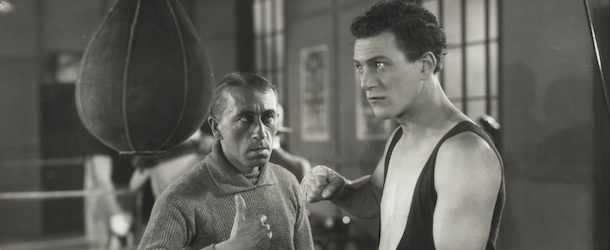by Chance Solem-Pfeifer
“One-Round” Jack Saunders and Bob Corby were always going to fight. It’s written into their relationship to each other as boxers and athletes. It’s the subtext to both of their relationships with “The Girl,” played by Lillian Hall-Davis in Alfred Hitchcock’s The Ring.
Their climactic confrontation in Hitchcock’s only original screenplay is prescripted from the moment they publicly appear on screen, posing and showboating. It will be violent, ultimate and — as we know from the subsequent century of sports drama — the unexpected should very likely be expected.
The seventh installment of Film Streams’ The Hitchcock 9 series will begin tonight at 7 p.m. with a live score of the 1927 silent film from Omaha’s Alex McManus (The Bruces, Lambchop, So-So Sailors), Aaron Markley (Gus & Call, So-So Sailors) and Daniel Ocanto (Big Harp).
While the trio of live-scorers say nothing in the film particularly jumped out at them demarcating it as Hitchcock’s only written work, both compositionally and topically, The Ring is notable among the Hitchcock 9 for its movement, physicality and energy. Because of the frame rate in which it was initially shot, the boxing sequences appear to happen in fast motion. And when Jack and Bob are not sparring with each other or other partners, Hitchcock’s early career foyers into scene-setting montage accelerate even establishing shots.
“It’s a very active film which seems to break from the others,” Ocanto says. “It definitely influenced the way I came to the project a little later, to bring in the feeling of the ‘20s and what you might experience in a boxing ring with the sound and sights.”
Like several of the other performers before them this spring — including Donald Sosin, Joe Knapp and Ben Brodin — this week’s trio says they’ll respond to what appears on the screen and to each other, playing with a significant degree of improvisation with a few cues and themes to guide them through The Ring.
“There’s a loose nature to most of what we’re playing, kind of a roadmap, but it’s crudely drawn,” Markley says.
On Thursday, instrumentation will be varied, plentiful and staggered. McManus will play cuatro guitar, violin, euphonium, trombone and autoharp. Markley and Ocanto will man diverse percussion, including vibes and xylophone, as well as Markley on keyboards. All three will take turns providing percussion via a wooden box.
“Alex just kept bringing things over,” Markley says. “Alex and I got together a couple times before we started playing and one of the discussions was: ’What do you want the instrumentation to be? Well, this what we both have. Let’s put them all in one room and start watching the film and see what happens.’
I think it is maybe a way to keep the film interesting for us.”
While Ocanto joined the project after McManus and Markley had already begun work on composing, he said he felt an obvious and organic allegiance to the roaring ‘20s timestamp of the film (though it is set in Britain, not the US) to compose in period.
“For me, the touchtone was always the Gene Krupa style drums and the Benny Goodman flare from the ‘20s and ‘30s. I definitely feel the setting and scenery worked its way into our process subconsciously. My whole thing was so informed by time and place that I immediately went to the Big Band Era.”
McManus says the themes they’ve fashioned for The Ring aren’t so much based around place, as Hitchcock tries to capture the buzzing moods of fairgrounds and arenas, but the developing relationships between the film’s principal love triangle. When this culminates in an in-ring confrontation between Jack and Bob, Ocanto says percussion and rhythms became paramount to suiting the physical violence and electricity on screen. Even soundless, there’s a kind of visual drumming to the way punches land on both men.
“Something happens that becomes a little more high octane when they’re in the ring and you experience it because the rhythm's right there,” Ocanto says. “I really hope that comes across.”
Chance Solem-Pfeifer is Hear Nebraska’s managing editor. Reach him at chancesp@hearnebraska.org.




